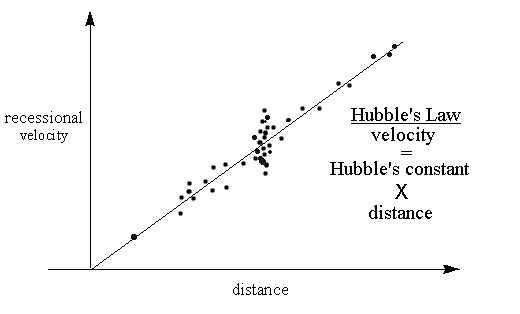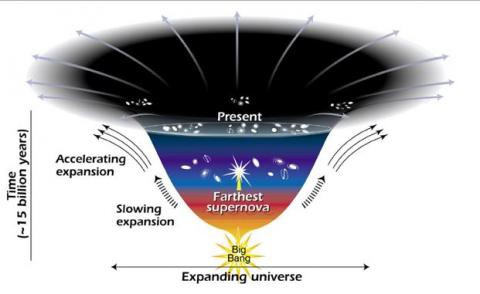Before the Discovery of Dark Energy:
When we think of the universe, we often picture matter that is pulled and held together by the force of gravity — forming planets, planetary systems, galaxies, clusters of galaxies, and ultimately the “web” of the universe. When we think about the birth of our universe, we picture a rapidly expanding cosmos that began to slow down in its expansion as it cooled. But what if I told you that this hasn’t always been the case?
At the end of the 20th century, observations done by NASA of supernovae millions to even billions of light years away using the Hubble Space Telescope showed that the universe’s rate of expansion in its earlier days was actually slower than it is today. This was a revolutionary discovery in Astronomy because it contradicts the theories of many astronomers — showing that the universe’s rate of expansion has not actually been slowing down due to gravity, but it has been accelerating. Scientists knew that there was an unknown, anti-gravity force causing this, yet to be discovered: Dark Energy.
What is Dark Energy?
Dark energy is a perplexing form of matter or energy that is accelerating the universe’s rate of expansion. Since it does not interact with any type of electromagnetic radiation, it is virtually invisible to us. However, rather astonishingly, 68% of all matter in the universe is composed of dark energy according to NASA. From the 32% that remains, 27% is composed of dark matter and only 5% is composed of visible matter (i.e., the matter that we can see and interact with). At this point in time, dark energy quite clearly dominates the universe, forcing the cosmos to expand at an ever-increasing rate.

How do we know about Dark Energy?
The effects of dark energy are evident primarily by their influence on the universe’s rate of expansion; specifically, the rate at which distant galaxies are receding from planet Earth. Deep space observations by advanced telescopes and intense analysis of ancient supernovae have provided convincing evidence that the universe’s rate of expansion is accelerating based on differences in the wavelengths of light reaching us from the supernovae overtime. Yes, you guessed it. I’m speaking of cosmological redshift — a phenomenon that will be explained more deeply later.
Dark Energy Vs. Dark Matter:
As explained before, dark energy and dark matter are the two opposing forces governing the physics of the universe. As their names suggest, they are impossible to see even with the most sophisticated instruments that can detect other wavelengths of light. The only way to analyze them is by studying their interactions with other forms of matter in the universe.
Now you may ask, what’s the difference between the two? Dark energy is the force that’s trying to accelerate the universe’s rate of expansion, while on the contrary, dark matter tries to decelerate the universe’s rate of expansion. Dark energy essentially tries to push objects in the universe apart from each other, while conversely, dark matter is the force that tries to pull objects together. In other words, dark matter interacts with gravity while dark energy repulses it.
In its early days, dark matter dominated the universe, forcing its rate of expansion to slow down following the Big Bang. However, figures show that between 5 and 7 billion years ago, the anti-gravity force of dark energy took over dark matter and began to dominate the universe, reversing its rate of expansion. To this day, it still remains a mystery to scientists as to why this occurred. However, for what we do know, we are fortunate that dark matter dominated the early universe otherwise there would be no planets, stars or galaxies and the universe would be a painfully uneventful void of pure oblivion.
This cosmic tug of war has been going on since the birth of the universe, and from here on as the universe expands endlessly, dark energy’s domination will only continue to increase.
Weakly Interacting Massive Particles:
Weakly Interacting Massive Particles (WIMPs) are abnormally heavy, electromagnetically neutral subatomic particles that are hypothesized to be the main constituents of both dark energy and dark matter and are therefore thought to make up 90–95% of all particles in the universe. What indicates that these particles are electromagnetically neutral is the absence of light that is absorbed or emitted by them, which is why they are invisible to us. This, again, is because WIMPs — like dark energy/matter as a whole — do not interact with electromagnetic radiation in any shape or form. These hypothetical particles are speculated to move slowly through space and time due to their abnormally large weight. Their presence can be detected only through gamma rays which are released when they annihilate each other. Scientists are now investing loads of money into research to measure the properties of WIMPs by observing the nature of their collisions and how they annihilate each other in particle accelerators and cyclotrons.

Measuring and Calculating The Rate of Expansion of The Universe
It has only been for the last half of its life that the universe has been expanding at an accelerated rate. The rate of expansion is becoming faster by the second, even faster than the speed of light, therefore the laws of physics as we know them break down when we try to calculate the speed at which the universe is expanding.
Using distance measurements between us and the furthest astronomical objects we can observe in relation to cosmological redshift calculations, we can provide convincing evidence that this phenomenon is true. This can be confirmed using Hubble’s constant, which mathematically demonstrates that distant galaxies are moving away from Earth at speeds proportional to their distance.

Cosmological Redshift:
As described earlier, cosmological redshift is a key phenomenon used to measure the rate of the universe’s expansion by analyzing the rate at which distant galaxies recede from Earth. Below is a summary of this phenomenon in point form:
Redshift is caused by the expansion of space which forces celestial objects to move apart from each other. The radiation emitted from one object relative to another gets stretched and shifted towards the red portion of the visible light spectrum, hence the name “red shift”.
As demonstrated by Hubble’s constant which I explained earlier, recessional velocity increases with distance. This means that objects further away move apart from us at a greater speed and thus exhibit more red light than do objects that are closer to us.
This phenomenon is arguably the most compelling piece of scientific evidence that confirms the existence of dark energy, and physicists have used it to calculate the effects of dark energy on the universe’s rate of expansion with ever more precision.

VISUALIZATION: The Doppler Effect & Cosmological Redshift
The concept of Cosmological Redshift is very similar to that of the Doppler Effect. As you can see above, there is a source of sound moving towards the front observer and away from the back observer.
Due to this particular motion, the front observer will experience a higher pitched sound due to sound waves with shorter wavelengths and thus greater frequency, while the back observer will experience a lower pitched sound due to sound waves with longer wavelengths and thus lower frequency.
Similarly, when a galaxy moves towards an observer, as demonstrated on the right, blueshift occurs as the wavelength of the light waves decreases, but when the galaxy recedes from the observer, redshift occurs as the wavelength of the light waves increases.
These two concepts in Physics are based on the same underlying principle. The only difference is that redshift deals with light waves, while the doppler effect deals with sound waves.
Cosmological Constant:
The cosmological constant is an important constant in the field of astrophysics that arises from Einstein’s field equations of General Relativity. It describes the energy density or vacuum energy of space, which ultimately explains the universe’s accelerating rate of expansion. The cosmological constant is closely associated with the concepts of dark energy and quintessence (which is a hypothetical form of dark energy) and is depicted by the Greek letter Λ (Lambda). This incredible piece of work was thought to be the biggest blunder of Einstein’s career but is now regarded as one of the most spectacular equations in all of physics and astronomy.
The Fate of The Universe in The Hands of Dark Energy
Big Rip Vs. Big Crunch Theory:
The universe could end in one of two main agreed-upon ways. One is a Big Rip, and the other is a Big Crunch.
According to the Big Rip Theory, stars will literally be ripped apart from each other, and solar systems such as ours would lose the gravitational strength to remain together. Eventually, the immense force of dark energy will rip the last atoms apart, resulting in an empty void of elementary particles separated at great distances.
Unless the expanding universe could not combat the collective inward pull of dark matter’s gravity, it would die in a Big Crunch. In this theory, the universe’s expansion would reverse and all the matter and energy in the universe would clump together into a space that’s a tiny fraction of the size of a proton — comparable to the conditions of the Big Bang.
Consequences of the Universe’s Continuing Expansion:
As the universe continues to expand, space becomes colder and less dense. As distant astronomical objects move further away from us, we may eventually not be able to see them anymore as the light they emit becomes more and more stretched until it one day exits the range of the entire electromagnetic spectrum. Furthermore, space travel to distant galaxies may become physically impossible even at the speed of light as the galaxies would have travelled so far and would be travelling at such a fast speed away from us that we’d chase them forever without ever actually reaching the galaxies.
As a result of the universe’s current rate of expansion due to dark energy, we would forever be confined to our local cluster of galaxies: the Virgo supercluster. Thus, the time to explore and learn as much as we can about the universe is now. We must take advantage of the technology we have to advance our understanding of the universe while we can, and while it’s still feasible.







